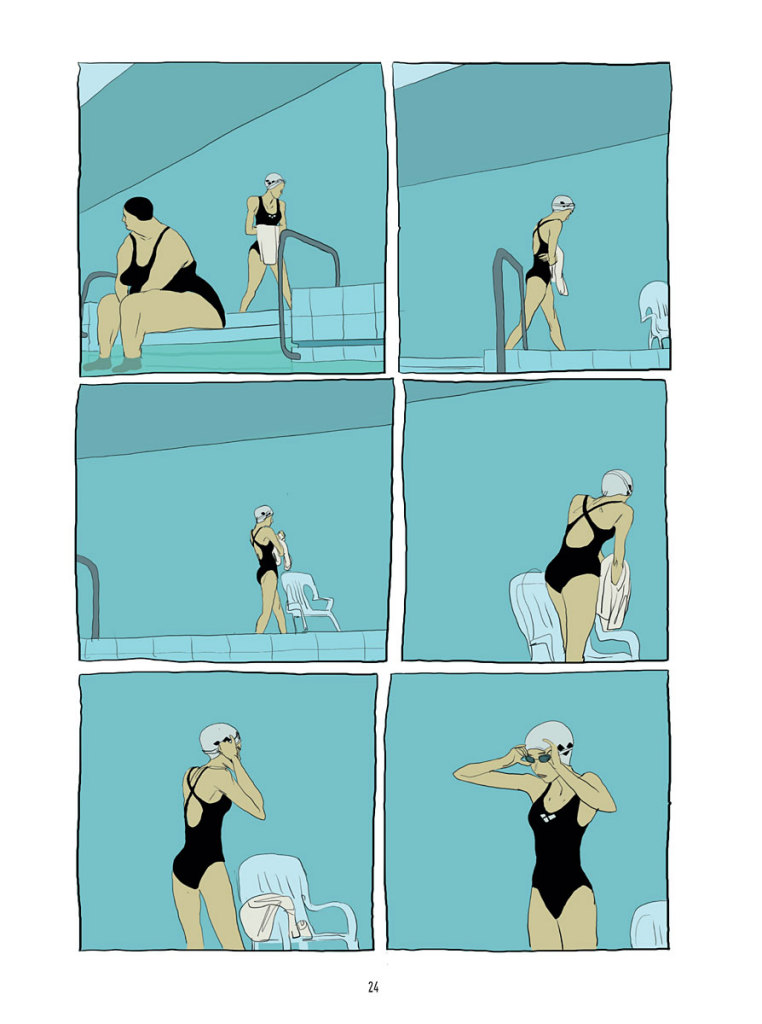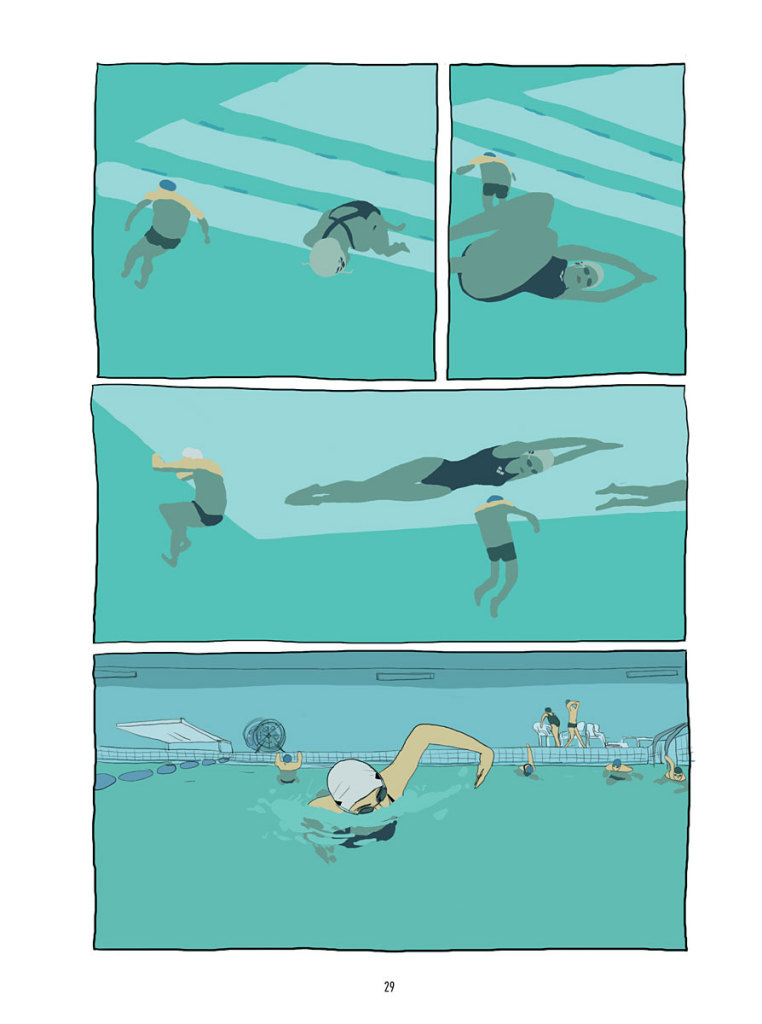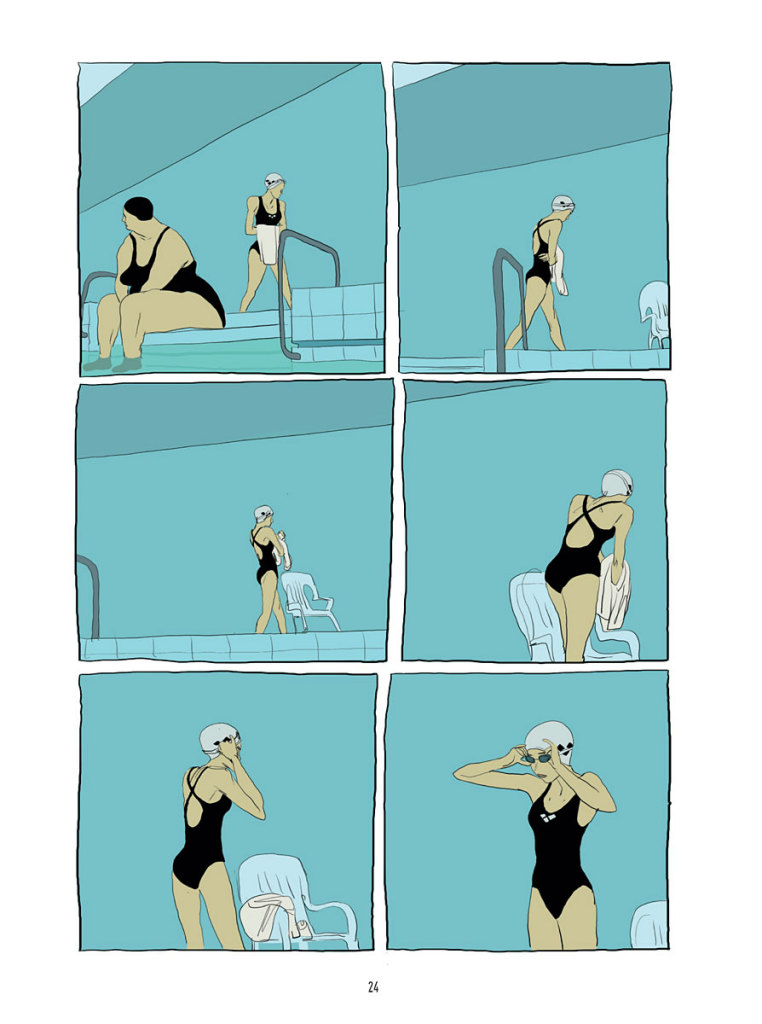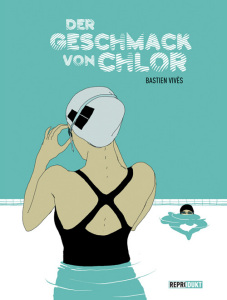Smak chloru / Taste of chlorine
Historia pewnego smaku. O tym, co nieuchwytne i czego nie sposób zgłębić.
Kadry niemal bez reszty zatopione w ciszy, a przy tym ożywione płynnymi – choć nieraz nieco niezdarnymi – ruchami. Czas wypełniony swoistą choreografią: powtarzalnymi, rytmicznymi gestami, przeciągłymi bądź krótkimi, ukradkowymi spojrzeniami. Turkusowa woda rozmywająca wszelkie kontury i zniekształcająca formy – to pierwsze wrażenia, jakie pozostawia po sobie Der Geschmack von Chlor (po polsku: smak chloru) Bastiena Vivèsa.
W komiksie wydanym nakładem niemieckojęzycznej oficyny Reprodukt słowo „płynąć” – podobnie jak i tytułowy smak chloru – nabiera ciekawych znaczeń. Podczas lektury opowiadanej przez Vivèsa historii na pierwszy plan wysuwają się skojarzenia z Heraklitowską zasadą panta rhei według której wszystko płynie, a także ulega zmianom. Owa płynność, niestałość ma w albumie francuskiego rysownika spore znaczenie. Jednak równie istotna wydaje się być w nim relacja pomiędzy tym co wewnętrzne i zewnętrzne. Między spojrzeniem powierzchownym a sięgającym głębiej.
Cała historia z pływaniem zaczyna się dla głównego bohatera od nieprzyjemnego obowiązku – suchego zalecenia fizjoterapeuty, którego zmuszony jest pewnego dnia odwiedzić. Z początku wizyty na basenie są dla młodego chłopaka czymś, co trzeba po prostu odbębnić. Smak chloru stanowi natomiast przykry efekt uboczny nurzania się w owym dziwnym turkusowo-kafelkowym otoczeniu, gdzie z innymi ludźmi dzieli się wodę i przestrzeń osobistą, chociaż tak naprawdę nie ma się z nimi nic wspólnego. Na tym obcym terytorium, gdzie nieraz nie sposób uniknąć niepożądanego kontaktu fizycznego lub czyjegoś osobliwego spojrzenia, trudno znaleźć cokolwiek, na czym można by było zawiesić wzrok na dłużej. Pozostaje tylko pląsanie w wodzie. Co więc można począć, gdy brakuje już do niego sił lub motywacji? Częste pauzy w pływaniu wymuszają na głównym bohaterze poszukiwanie jakiejkolwiek rozrywki dla oczu. W końcu dostrzega on jednak coś, a w zasadzie to kogoś, kto wzbudza jego zainteresowanie. Od momentu dostrzeżenia owej tajemniczej osoby – dodajmy: płci przeciwnej – wszystko w odczuciu naszego bohatera powoli zaczyna wyglądać/smakować inaczej.
Akcja Der Geschmack von Chlor rozwija się bez pośpiechu, gdzieniegdzie mniej lub bardziej dynamicznie, jednakże w tempie umożliwiającym kosztowanie chwili, gestów oraz innych niuansów, z których utkana jest opowieść Vivèsa. Rysownik co prawda zapełnia plansze wieloma kadrami, nie skąpi sobie jednak miejsca na takie detale jak drobne wymiany spojrzeń, subtelne gesty. Ba! Często nawet pozostawia czytelnika sam na sam z jednostajnym widokiem basenowego sufitu.
Szczególnie warte uwagi jest to, jak swobodnie rysownik ten operuje planami, punktami widzenia, nieraz wplatając do opowieści podobne ujęcia, sytuacje by w delikatny sposób zakomunikować czytelnikowi drobne zmiany nastawienia/nastroju zachodzące w postaciach. Bastien Vivès dostarcza czytelnikowi tak niewiele informacji na temat bohaterów swojej opowiastki, że ich uważna obserwacja to właściwie jedyna sposobność, by uchwycić jakiś szczegół, który określiłby ich jako osoby. Można zatem spokojnie powiedzieć, że obydwie bezimienne (!) pierwszoplanowe postaci komiksu odbiorca zna jedynie powierzchownie – z widzenia. Jawią się mu niczym osoby napotkane przypadkiem, w miejscu publicznym. Są ledwo zarysowane a interesujące stają się dopiero wówczas, gdy zachodzi między nimi jakaś interakcja. Gdy narasta swoista gra spojrzeń, w której chłopak występuje w roli podmiotu obserwującego, a dziewczyna – obiektu obserwacji i podmiotu niezgłębionego, tajemniczego. Rzecz jasna uczestnikiem owej gry spojrzeń jest także czytelnik, którego wzrokiem w milczeniu steruje autor.
Pod koniec lektury odbiorca, zaintrygowany tą kuriozalną sytuacją, pragnie – wzorem głównego bohatera – zanurzyć się w historii głębiej, uchwycić coś, co kryje się pod powierzchnią. Niemniej okazuje się to niemożliwe. Opowieść Vivèsa wymyka się próbom interpretacji czy analizy. Jest równie nieuchwytna co nieznajoma, która dla głównej postaci męskiej do końca pozostaje tajemniczym, nieodgadnionym obiektem obserwacji/fascynacji. Der Geschmack von Chlor jest więc dla czytelnika nie tylko lekcją patrzenia, umiejętnego przepływania wzrokiem z kadru na kadr, lecz również sięgania w głąb i godzenia się na niewiadome, tajemnice. Na to wszystko, czego nie sposób w pełni dookreślić.
The story of a certain taste.
Frames almost entirely immersed in silence and at the same time vivid, animate with movement. Pages filled with a some sort of choreography; repeated gestures, long gazes or short, secretive glimpses. Turquoise coloured water dispersing outlines and distorting all forms – these are the first impressions one gets having read Der Geschmack von Chlor (in English: the taste of chlorine) by Bastien Vivès. This comic book, published by Reprodukt (the German editor) encourages the reader to look for the unobvious meanings of words like 'swim’, 'taste/flavour’ or 'flow’. The first thing that comes to mind while reading Vivès’ story is the association with the panta rhei aphorism characterising Heraclitus’ thought on the ever-present change of things. This liquid, ever-changing state seems to have a crucial meaning in the French artist’s story. However, one should not forget that the relations between the internal and external, the depth seeking gaze and the superficial glimpse are also of great importance.
The whole 'swimming adventure’ began for the main (male) character when a physiotherapist told him to visit the swimming pool in order to work on his back problems. At first the pool visits are a drag, something dull that the young protagonist is just trying to get over with. Whereas the taste of chlorine is an unpleasant side effect of spending time in this weird greenish blue place where one shares their personal space with people with whom one has virtually nothing in common. This strange territory, where one very often fails to avoid random physical or eye contact, it is difficult to find something interesting to rest one’s eyes on. This leaves our male character with nothing but swimming. But what can he do if he lacks the strength or motivation to stick to it? The often recurrent breaks result in him seeking some kind of entertainment for his eyes. Finally, he finds something, or rather: someone, intriguing to look at – a young, attractive woman and from this moment on everything starts to change for him.
Der Geschmack von Chlor is a story told without haste. Even though the author makes it sometimes more or less dynamic, he always allows the reader to take a moment and appreciate all the little things that make the story so engaging. While it is true that Vivès fills the pages of the comic book with many frames, one never gets the feeling of excess or horror vacui. The French author proves to be very good at composing panels and giving the reader a sense of space through subtle and modest drawings. Moreover this comic book shows that Vivès is a tentative observer, good at capturing the nuances of the human body, gestures etc. Yet, these are not the only things he eagerly depicts in his story. He even presents the reader with several frames devoted solely to the construction of the swim centre’s ceiling.
Nevertheless, what really catches the reader’s attention is the ease visible in the way the author operates with frames, viewpoints, planes. Sometimes Vivès even 'stages’ several similar situations, repeats scenes where the character utters the same words with different emphasis or meaning just to show the changes that he (i.e. the young man) is experiencing. Actually, the French comic artist offers so little information about his protagonists that observing them is the only way for the reader to find out anything about them; anything that would describe their personalities etc. In other words, one gets to know Vivès’ nameless characters only by sight – superficially. Both of them – the young man and the girl that catches his eye at the pool – can be perceived as people randomly met in a public place. They are barely outlined and become interesting only after they interact with each other (engage in conversation, eye contact etc.). This is the moment when the reader and the protagonists become parts of a 'looking game’ or 'mechanism’ of some sort. And so the reader observes the male character who observes the female character whose point of view/insights are a mystery to all.
Heading towards the last pages of Der Geschmack von Chlor one is so intrigued by this situation that they wish – just like the male protagonist – to immerse in the story, dig deeper for hidden meanings. However, it turns out to be unattainable and vague. Vivès’ comics seems to escape any attempt of interpretation or analysis. It is as unattainable as the female character who – throughout the whole book – remains a mysterious, obscure object of interest for her male admirer. That is why Der Geschmack von Chlor is not only a lesson in looking/seeing, in observing the internal, external, the superficial and the deep, but also a lesson in letting go; accepting the mysteries. Accepting everything that changes and cannot be defined.
// tekst i tłumaczenie: Magdalena Rucińska
Ilustracje: copyright (for the German edition) Bastien Vivès/Reprodukt.



